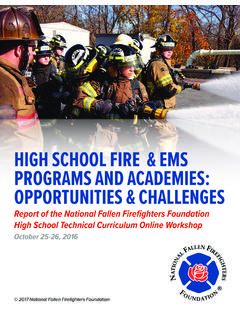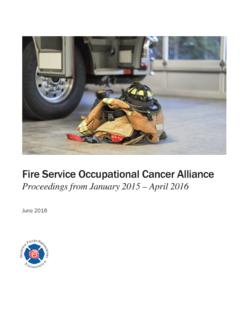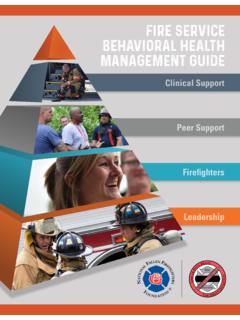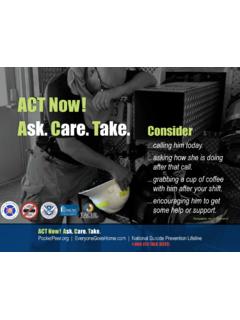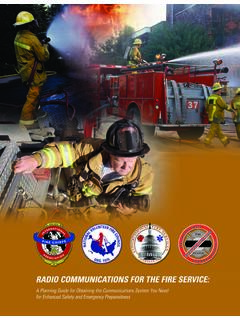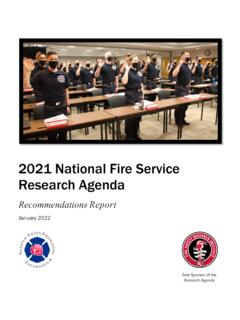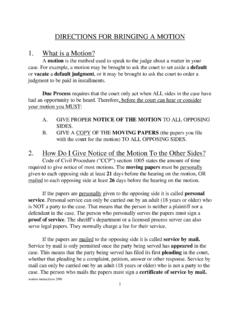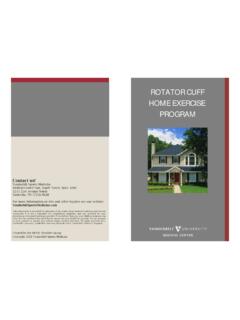Transcription of EMERGENCY VEHICLE RESPONSE GUIDELINES
1 TheCommuniqu ..a technical reference bulletin by the Risk ControlServices Department of the Glatfelter Insurance GroupThis is a sample guideline furnished to you by VFIS. Your organization should review it and make the necessarymodifications to meet the needs of your organization. The intent of this guideline is to assist you in reducingexposure to the risk of injury to personnel and the general public from injury or property damage. For additionalinformation on this topic, you may contact your VFIS Risk Control Representative at 1-800-233-1957 2000 VFIS, All Rights ReservedEMERGENCY VEHICLE RESPONSE GUIDELINESIn today s EMERGENCY services organizations, there is a growing need for thedevelopment and use of standard operating GUIDELINES and issue specific training.
2 Oneof the areas that requires a great deal of attention is the operation of EMERGENCY officers, as well as drivers, need to recognize the fact that the EMERGENCY vehicleresponse is the basis for the success or failure of all other EMERGENCY functions. Theseexpensive vehicles carry all of the portable EMERGENCY equipment in addition to all ofthe personnel of the organization. Without the safe conveyance of these vehicles to theemergency scene, the EMERGENCY service organization cannot achieve its mission ofsaving lives and protecting sound EMERGENCY VEHICLE RESPONSE GUIDELINES in place will assist the emergencyservice organization in providing sound direction to its officers and drivers.
3 Thefollowing GUIDELINES may be used to implement, supplement or enhance the emergencyvehicle RESPONSE policies and provide the basis for driver training for most emergencyservice VEHICLE RESPONSEOPERATING GUIDELINESOF THE_____PurposeResponding to any EMERGENCY call, the _____ places a great dealof responsibility on the drivers of our EMERGENCY vehicles. Not only must EMERGENCY vehicles driversprovide prompt conveyance of the apparatus, equipment, and personnel to provide service to those inneed, but as importantly, must accomplish this task in the safest and most prudent manner VEHICLE drivers have in their care, custody and control most of the major assets possessedby this organization (the VEHICLE , portable equipment, personnel).
4 EMERGENCY VEHICLE drivers also havea higher standard of care to provide to the general motoring public and must make every attemptpossible to provide due regard for the safety of others. Drivers must constantly monitor and reduce theamount of risk and exposure to potential losses during each and every RESPONSE . Safe arrival at theemergency scene shall be, and must always remain, the first priority of all EMERGENCY VEHICLE order to accomplish this enormous task all EMERGENCY vehicles drivers shall become familiar with,and constantly abide by the following policies and Circle of safetyPrior to entering the cab and starting the VEHICLE , the EMERGENCY VEHICLE driver shall make a circle ofsafety around the VEHICLE to see that all equipment is secured, that all compartment doors are securelyclosed and any physical obstructions moved out of the way.
5 During the circle of safety the emergencyvehicle driver shall encircle the vehicles and visually inspect all 4 sides and the top of the vehiclebefore entering the cab. He/she should also verify right side and rear clearance with the person ridingin the officer position. This shall be conducted prior to moving the VEHICLE regardless of whether ornot the VEHICLE is about to leave on an EMERGENCY or Warning devices and true emergenciesWhen responding to a true emergency1, all audible and visual warning devices will be operated at alltimes regardless of time of day and/or traffic conditions.
6 All EMERGENCY VEHICLE driver s mustunderstand that warning devices are not always effective in making other VEHICLE operators aware ofyour presence. Warning devices only request the right-of-way, they do not insure the right-of-way. 1 The definition of a true EMERGENCY is a situation in which there is a high probability of death or serious injury to anindividual or significant property loss, and actions by an EMERGENCY VEHICLE driver may reduce the seriousness of VEHICLE control and right-of-wayAll drivers shall attempt to maintain control of the VEHICLE that they are operating in such a manner asto provide the maximum level of safety for both their passengers and the general public.
7 Emergencyvehicle drivers should be aware that the civilian VEHICLE operators may not react in the manner inwhich is expected or felt to be appropriate. An attempt should be made to have options available whenpassing or overtaking vehicles. If another VEHICLE operator fails to yield the right of way to anemergency VEHICLE , the EMERGENCY VEHICLE driver can not force the right of way, nor can you assumethe right of way, therefore you do not have the right of way until the other VEHICLE yields to EMERGENCY VEHICLE driver shall be aware of his/her rate of closure on other vehicles andpedestrians at all times to make sure that a safe following distance is established and maintained.
8 Alldrivers shall follow the rule for safe following distance and allow 1 second of following distance forevery 10 feet of VEHICLE length for speeds under 40 mph and add 1 additional second for each 10 mphfor speeds over 40 RESPONSE speedsWhen responding to a true EMERGENCY only, drivers shall operate the VEHICLE they are driving at asclose to the posted speed limit as possible, but not to exceed ten (10) miles per hour over the postedspeed limit, conditions permitting. Examples of conditions requiring slower RESPONSE speeds includebut are not limited to; slippery road conditions inclement weather poor visibility heavy or congested traffic conditions sharp curves45.
9 Intersection PracticesExtreme care should be taken when approaching any intersection as intersections are the locationsresponsible for a large percentage of major accidents involving EMERGENCY vehicles. Drivers arerequired to practice the organizations intersection operating GUIDELINES during all EMERGENCY intersectionsAny intersection that does not offer a control device (stop sign, yield or traffic signal) in the directionof travel of the EMERGENCY VEHICLE or where a traffic control signal is green upon the approach of theemergency VEHICLE all EMERGENCY VEHICLE drivers should do the following: Scan the intersection for possible hazards (right turns on red, pedestrians, vehicles traveling fast,etc.)
10 Observe traffic in all 4 directions (left, right, front, rear) Slow down if any potential hazards are detected and cover the brake pedal with the drivers foot. Change the siren cadence not less than 200 from intersection Avoid using the opposing lane of traffic if at all VEHICLE drivers should always be prepared to stop. If another VEHICLE operator fails to yieldthe right of way to an EMERGENCY VEHICLE , the EMERGENCY VEHICLE driver can not force the right of way,nor can you assume the right of way, therefore you do not have the right of way until the other vehicleyields to intersectionsAny intersection controlled by a stop sign, yield sign, yellow traffic light or a red traffic light requires acomplete stop by the EMERGENCY VEHICLE driver.

